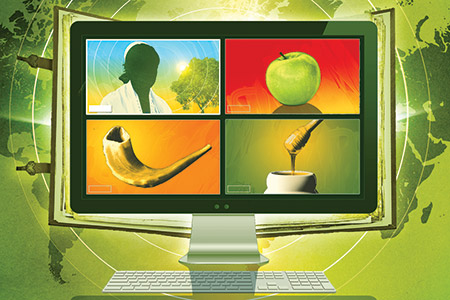Holidays
Rosh Hashanah
Jewish Tradition Is the Ultimate Renewable Energy

Ma nishtanah rosh hashanah hazeh mikol rashei hashanim? How is this Rosh Hashanah different from all other Rosh Hashanahs? In more ways than you need me to remind you. And in none.
Yes, many of us will be staring at a screen instead of a Mahzor, or holiday prayer book. But those who nod off during the rabbi’s sermon will now be able to do so even less conspicuously. And those who prefer the “liturgy” of a synagogue chat will be able to catch up not just with the person sitting next to them but also with someone sitting across the world. So, not much has changed. And yet, everything has.
In the early years of my rabbinic career, by the time July rolled around, I’d begin thinking about what message to share during the High Holidays. Until one summer I realized that, although I still needed to write a new sermon, I didn’t actually need a new message each year.
While the spiritual, social and political landscape of any given year frames a High Holiday sermon, the message remains consistent, no matter which rabbi is delivering it: Think deeply about the life you’ve been given and how you’re living it. Take responsibility for the choices you’re making. Do better in the areas in which you can realistically make change. Be more mindful of how your shortcomings are experienced by those around you. Return to the core of your potential as a Jew, and as a human being.
In fact, scratch deep enough and we begin to see the underlying link connecting the various sacred days on our Jewish calendar. Rosh Hashanah renews creation, personal and global; Yom Kippur renews relationships; Sukkot renews our capacity for gratitude; Hanukkah renews the light of Jewish pride; Tu B’Shevat renews our relationship to the earth; Purim renews human agency; Pesach renews our journey toward freedom; Yom Hashoah renews memory as a catalyst for change; Yom Hazikaron and Yom Ha’atzmaut renew appreciation for the miraculous rebirth of the State of Israel, for all the sacrifices people have made for the country and for the urgency to fulfill her destiny as a land of peace and justice; Shavuot renews the place of Torah in our lives; Tisha B’Av renews our vision of building sanctuaries of love, not stones—which brings us back to Rosh Hashanah.
For over 4,000 years, Judaism has exemplified a commitment to continuous growth, which explains our ongoing relevance and resonance in a radically changed, and changing, world. Ordaining women and embracing LGBTQ Jews are two modern examples.
Through narrative, law, ethics, ritual and prayer, our tradition teaches that we have the capacity to be in an ongoing state of becoming. It recognizes the possibility of re-creation not only in every sunrise but in every moment we’re gifted to be alive. It inspires continuous introspection and purposeful action to keep bridging the gap between who we are and whom we wish to be.
The pages of our debate-filled holy texts canonize not creed, but a commitment to endless intellectual creativity. Generations of rabbinic responsa dictate not Jewish behaviors but rather the primacy of relationship to Jewish law, whereby personal and collective norms are continually reshaped by the ever-changing context in which they are lived. Teshuvah (repentance/return), which, according to the sages, was created even before the birth of the world, ensures our capacity to right our wrongs and redeem our failures, prodding humanity along an eternally unfolding path toward redemption.
This New Year, as most Jews head to shul virtually and enter sanctuaries with the push of a button, let’s travel there as we always have: fueled by clean, pure, renewable Jewish energy for ourselves, our people and our planet.
Rabbi Adina Lewittes is the founder of Sha’ar, a Jewish community in the New Jersey/New York City area providing multiple gateways into Jewish life suffused with the values of shared leadership, sustainability and collaboration.










 Facebook
Facebook Instagram
Instagram Twitter
Twitter
Leave a Reply